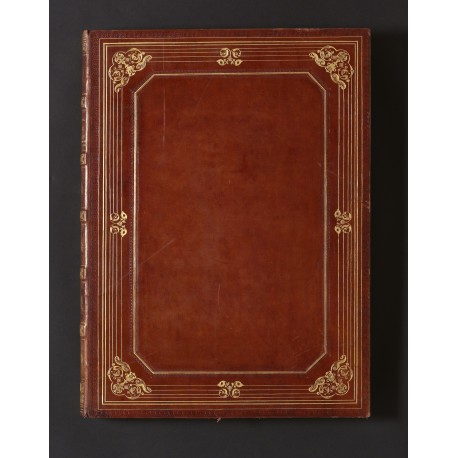 View larger
View larger
Der Apollotempel zu Bassae in Arcadien, und die daselbst ausgegrabenen Bildwerke
- Subjects
- Archaeology, Greek & Roman
- Architecture, Greek
- Book illustration - Artists, Italian - Cipriani (Giovanni Battista), 1766-1839
- Greece - Description and travel
- Sculpture, Greco-Roman
- Authors/Creators
- Stackelberg, Otto Magnus von, Baron, 1787-1837
- Artists/Illustrators
- Cipriani, Giovanni Battista, 1766-1839
- Gmelin, Wilhelm Friedrich, 1760-1820
- Marchetti, Domenico, 1780-1844
- Reinhart, Johann Christian, 1761-1847
- Printers/Publishers
- Andreä (Gedruckt mit Andreäischen Schriften), 1826
- Other names
- Brøndsted, Peter Oluf, 1780-1842
- Cockerell, Charles Robert, 1788-1863
- Foster, John, c. 1787-1846
- Gropius, Georg Christian, 1776-1850
- Haller von Hallerstein, Karl, 1774-1817
- Linckh (Kinckh), Jacob, 1787-1841
- Selenka, Philipp, 1803-1850
Stackelberg, Otto Magnus von, Baron
Tallinn, Estonia 1787 – 1837 St. Petersburg
Der Apollotempel zu Bassae in Arcadien, und die daselbst ausgegrabenen Bildwerke.
Rome & Frankfurt am Main (text ‘Gedruckt mit Andreäischen Schriften’), 1826
folio (535 × 378 mm), (74) ff. letterpress, signed 1–372 and paginated 1–147 (1), with seven vignettes printed with the text; plus thirty-one numbered engraved plates (pl. vi folding).
Occasional spotting in margins; otherwise a fine copy. Edges of binding rubbed.
bound in contemporary russia leather, covers decorated in gilt; engraved ticket on cream paper Gebunden bei Ph. Selenka in Wiesbaden.
First edition of Stackelberg’s account of the excavations at Bassai (Phigaleia) in July–August 1812, when he worked alongside Baron Carl Haller von Hallerstein, Peter Oluf Brøndsted, John Foster, Georg Christian Gropius, and Jacob Linckh, under the nominal leadership of Charles Robert Cockerell, who was in Sicily at the time. Although Stackelberg had assisted Cockerell in planning the excavation, also in the removal of the marbles to a depot in Zante, where they were later auctioned, he was not one of the group of ‘Proprietors’, and (like Brøndsted) did not share in the profits.1
The participants had reached an understanding: publication of the Bassai marbles was to be a communal undertaking. Brøndsted, Foster, Haller, Linckh, Cockerell and Stackelberg were each to make a contribution. The joint publication never came to pass; instead, Stackelberg produced his book fourteen years later, and Cockerell finally published the official version in 1860.2 Stackelberg’s work contains an archaeological description of the temple (built around 430 bc in the Doric order, reputedly by Iktinos, one of the architects of the Parthenon), with engravings of its sculptured frieze carved with two mythical battles, showing Lapiths fighting Centaurs and Greeks fighting Amazons (these were purchased by the Prince of Wales in the auction held on 1 May 1814, and are now in the British Museum). Also printed is a small collection of Greek folk songs.
In 1817 Stackelberg settled in Rome, where he arranged to have his drawings of Bassai engraved by Angelo Testa, G.B. Cipriani, Domenico Marchetti, and others. Further engravings were provided by Johann Christian Reinhart3 and Wilhelm Friedrich Gmelin (pl. xxvi). In February 1821 Stackelberg showed a set of the plates to Cockerell; work on the text lagged, and five more years elapsed before publication (at Frankfurt in 1826).

Copies appear infrequently in the market4 and it is notable that none was obtained for the Blackmer collection.5 Our copy is in a handsome binding by Philipp Selenka (1803–1850) of Wiesbaden, brother of Johann Jacob Selenka (1801–1871), Hofbuchbinder in Braunschweig.6
references Gerhart Rodenwaldt, Otto Magnus von Stackelberg: der Entdecker der griechischen Landschaft, 1786–1837 (Munich 1957), pp.28–29 and figs. 24, 26; The age of Neo-classicism: the Royal Academy and the Victoria and Albert Museum, London, 9 September–19 November 1972 ([London] 1972), no. 940
1. Frederick A Cooper, The Temple of Apollo Bassitas, Volume 1, The Architecture (Princeton 1996), pp.25–26, and passim.
2. Charles Robert Cockerell, The Temples of Jupiter Panhellenius at Ægina, and of Apollo Epicurius at Bassæ near Phigaleia in Arcadia (London 1860).
3. Andreas Andresen, Die deutschen Maler-Radirer (Leipzig 1866), i, pp.344–46, nos. 164–166; F. Carlo Schmid, Naturansichten und Ideallandschaften: die Landschaftsgraphik von Johann Christian Reinhart und seinem Umkreis (Berlin 1998), pp.318–320.
4. Most recently ● Christie’s, Paris, 9 June 2006, lot 131 (from the collection of Victor Duchateaux) ● Sotheby’s, 20 October 1988, lot 195 (unbound in portfolio).
5. Cited by Leonora Navari, Greece and the Levant: the catalogue of the Henry Myron Blackmer collection of books and manuscripts (London 1989), p.336 no. 1591.
6. Two bindings by Philipp Selenka in the Fürstlich Waldecksche Hofbibliothek, Arolsen, are described by Rudolf-Alexander Schütte and Konrad Wiedemann, Einbandkunst vom frühmittelalter bis Jugendstil aus den Bibliotheken in Kassel und Arolsen, Universitätsbibliothek Kassel (Kassel 2002), p.54 no. 68 Abb. 51 and no. 70.


